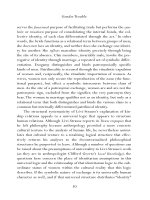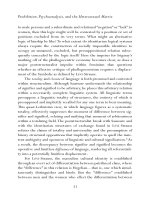GENDER TROUBLE 95
Bạn đang xem bản rút gọn của tài liệu. Xem và tải ngay bản đầy đủ của tài liệu tại đây (20.58 KB, 1 trang )
Gender Trouble
characteristic and, hence, in need of masking and who are in some
unspecified sense in need of protection. Lacan then states that this situation produces “the effect that the ideal or typical manifestations of
behaviour in both sexes, up to and including the act of sexual copulation, are entirely propelled into comedy” (84).
Lacan continues this exposition of heterosexual comedy by explaining that this “appearing as being” the Phallus that women are compelled to do is inevitably masquerade. The term is significant because it
suggests contradictory meanings: On the one hand, if the “being,” the
ontological specification of the Phallus, is masquerade, then it would
appear to reduce all being to a form of appearing, the appearance of
being, with the consequence that all gender ontology is reducible to
the play of appearances. On the other hand, masquerade suggests that
there is a “being” or ontological specification of femininity prior to the
masquerade, a feminine desire or demand that is masked and capable
of disclosure, that, indeed, might promise an eventual disruption and
displacement of the phallogocentric signifying economy.
At least two very different tasks can be discerned from the
ambiguous structure of Lacan’s analysis. On the one hand, masquerade
may be understood as the performative production of a sexual ontology, an appearing that makes itself convincing as a “being”; on the other
hand, masquerade can be read as a denial of a feminine desire that presupposes some prior ontological femininity regularly unrepresented
by the phallic economy. Irigaray remarks in such a vein that “the masquerade . . . is what women do . . . in order to participate in man’s
desire, but at the cost of giving up their own.”17 The former task would
engage a critical reflection on gender ontology as parodic (de)construction and, perhaps, pursue the mobile possibilities of the slippery
distinction between “appearing” and “being,” a radicalization of the
“comedic” dimension of sexual ontology only partially pursued by
Lacan. The latter would initiate feminist strategies of unmasking in
order to recover or release whatever feminine desire has remained
suppressed within the terms of the phallic economy.18
60









